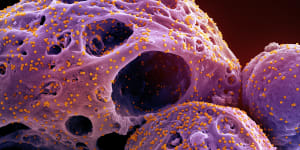“COVID-19 cases in NSW have continued to decline this week with all indicators showing we may be approaching the bottom of the wave,” the state’s Chief Medical Officer Dr Kerry Chant said on Thursday.

A colourised electron microscope image from the US National Institute of Allergy and Infectious Diseases shows cells (purple) infected with the Omicron strain of COVID-19 (orange).AP
In the week ending January 28,6812 people were diagnosed with COVID-19,a drop of 13.4 per cent since the previous week,the latest showed.
PCR testing was also down 10.6 per cent compared with the previous week,and the proportion of positive PCR tests was stable at about 9 per cent.
The seven-day rolling average of daily hospital admissions dropped to 39 by January 28,compared with 48 a week earlier,and emergency department presentations for COVID requiring an admission dropped from 134 to 113 over the same period.
In the week ending January 28,272 people with COVID-19 were admitted to hospital,28 were admitted to ICU and 86 COVID deaths were reported,the report showed.

The fact that the decline in case notifications and hospitalisations appeared to be slowing indicated “we may be approaching the bottom of this wave”,the report said.
But the highly mixed swarm of subvariants that drove the latest COVID wave was still circulating across NSW,with the subvariant XBF now dominant,the report said.
Subvariant researchers led by Associate Professor Stuart Turville,who heads virology and containment activities at the Kirby Institute at the University of NSW,said the community needed to move beyond talking about each variant at a singular level.
“There are literally hundreds of Omicron types that can be distinguished by their genetic footprint and even now in Australia,we have two co-dominating in our variant mix,” Turville and his colleagues wrote in theMedical Journal of Australia this week.
“While some may be more competitive (evade antibodies better or have a fitness edge in transmission),they are all variations on the same theme and pragmatically may indeed be better considered as various Omicron subgroups,” they said.
“How they enter our body has not diverged significantly to the point where one can be differentiated by targeting a different cell or tissue.”
Chant urged the public to continue to take simple steps to protect themselves and others.
“Don’t visit loved ones at higher risk of disease,hospitals,or aged care facilities if you have[COVID or] cold or flu-like symptoms even if they are mild,” she said.
“This advice still applies even if you have a negative rapid antigen test. RAT tests may not pick up COVID early in the illness and we also want to protect the most vulnerable people within these settings from other respiratory viruses such as flu and RSV[respiratory syncytial virus].
“Know if you’re eligible for antivirals and wear a mask in settings with people at risk of severe disease such as hospital and aged care facilities.”
The Morning Edition newsletter is our guide to the day’s most important and interesting stories,analysis and insights..